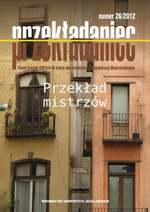Olgierd Wojtasiewicz – pionier myśli przekładoznawczej
Olgierd Wojtasiewicz: Father of Polish Translation Studies
Author(s): Krzysztof HejwowskiSubject(s): Language and Literature Studies
Published by: Wydawnictwo Uniwersytetu Jagiellońskiego
Keywords: Translation Studies; Olgierd Wojtasiewicz; equivalence; untranslability; linguistics
Summary/Abstract: Olgierd Wojtasiewicz was a translator (from Chinese into Polish, from English into Polish and from Polish into English) and a linguist. In 1957 he published a book entitled Wstęp do teorii tłumaczenia (An introduction to the theory of translation), which was one of the first academic publications on translation in Poland. Republished after almost forty years (Wojtasiewicz 1992), it proves to be still interesting and important. This resulted from Wojtasiewicz’s basic assumptions: texts are signals corresponding to certain mental states and a translation is equivalent to the original if it evokes a similar set of associations. Wojtasiewicz wrote of equivalence in translation two years before Jakobson and based his definition of translation on the principle of similar effect seven years before Nida. In his book, he concentrates mainly on the problem of “objective” untranslatability and divides its causes into two groups: structural differences between languages and conceptual differences between cultures/languages. Contrary to Catford, Wojtasiewicz realized that cultural differences were a much more difficult obstacle in translation than structural differences between languages and drew an optimistic conclusion: owing to the process of cultural rapprochement (mediated by translators), translating may become easier with time. Among the causes of untranslatability Wojtasiewicz describes allusions and the use of different language varieties in the original. According to him, geographical dialects are never fully translatable – it is not possible to replace a SL dialect with a TL one because of different cultural-historical associations evoked by the use of such dialects. Wojtasiewicz’s insights remain valuable after more than fifty years, and his book is still an obligatory reading for all those interested in translation.
Journal: Przekładaniec.
- Issue Year: 2012
- Issue No: 26
- Page Range: 108-114
- Page Count: 7
- Language: Polish

